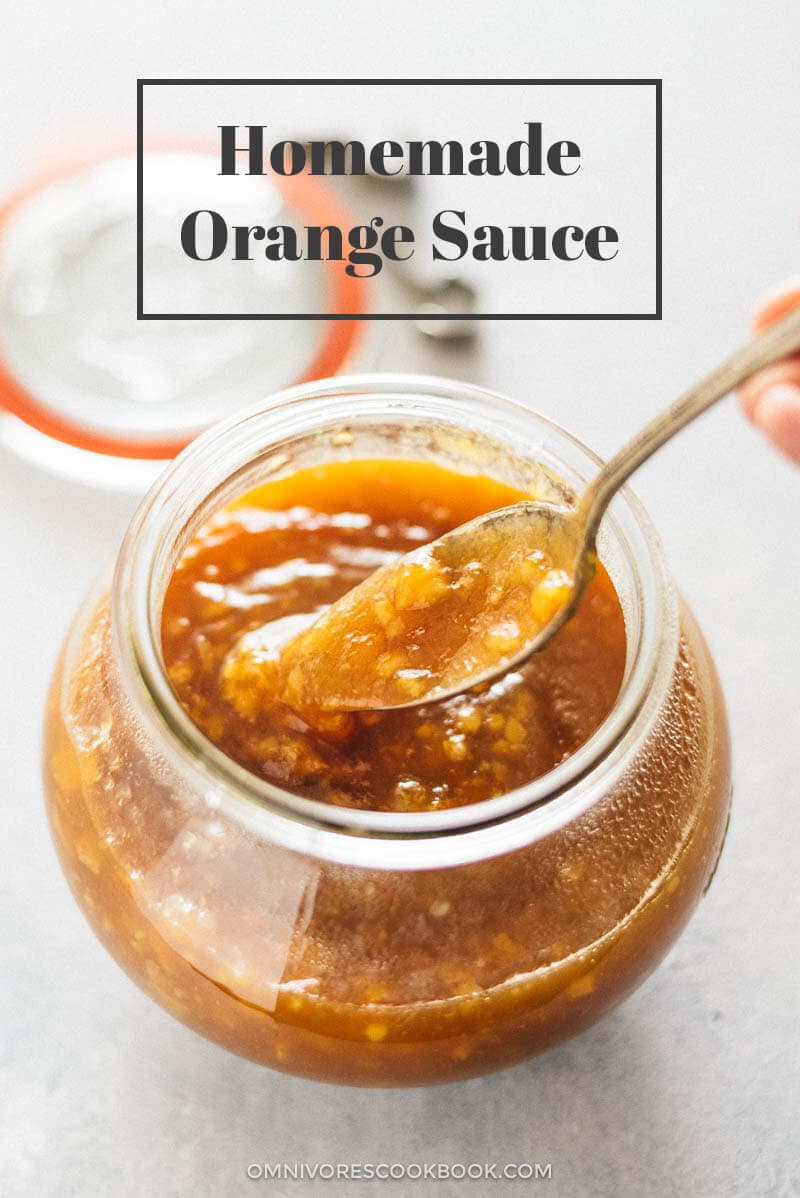
Do you want to whip up a healthy dinner on the table on a busy weeknight? Thinking about changing up flavors so dinner won’t be boring again?
Making stir fry sauce in advance is the perfect solution.
Over the years, I found out that mastering the few key components of stir frying is much more useful than just learning a recipe. That is – to understand the process of stir frying, how to choose and prep ingredients, and how to make a great stir fry sauce.
If you get these few tools under your belt, not only can you make your favorite takeout dish in your own kitchen that tastes even better than those in Chinese restaurants, but the whole process will become less intimidating – and the results more delicious!
Moreover, understanding the key techniques will make your meal planning and prepping more flexible, because you can use whatever ingredients you have on hand, instead of hunting down an ingredient just to follow through the recipe.
Even better, I will share all the secrets of how to use stir fry sauce to create quick and healthy meals, without stir-frying!
You ready? Let’s dive in!
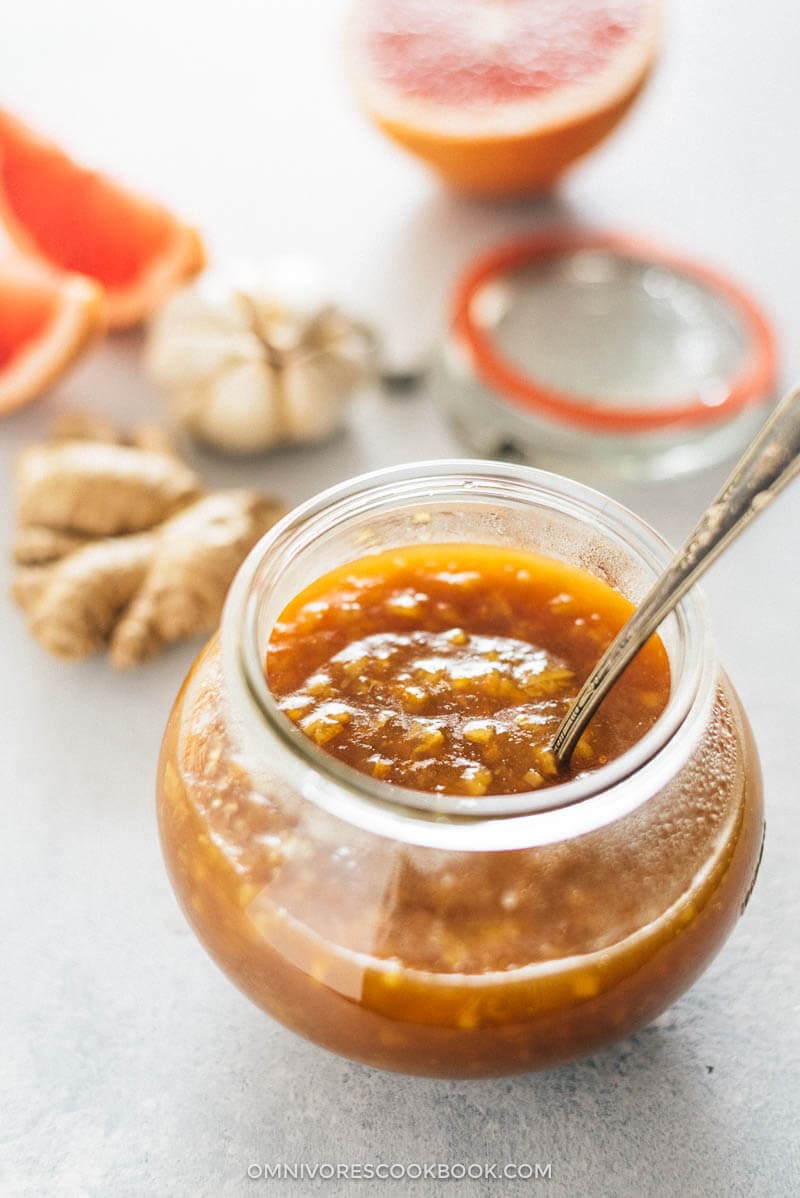
Today’s lesson is on how to prepare a stir fry sauce.
This is the easiest part, because all you need to do is add all the ingredients in a jar and shake to mix.
You can prepare stir fry sauce beforehand, like on the weekend, so there will be one less thing to do when you’re ready to cook in the week.
The benefit of preparing stir fry sauce in bulk is that you can use it to make several meals with totally different main ingredients. It saves you tons of time, but your everyday dinner will taste different.
Introducing homemade orange chicken sauce
Orange chicken, orange beef, orange cauliflowers… Orange is one of the most popular flavors on a Chinese restaurant menu. So, I chose to start my stir fry sauce series with it.
In China we do not have orange sauce – we call it tangerine sauce instead. Rather than using orange juice and orange zest, we use rehydrated dried aged tangerine peels to impart a distinctive zesty and citrus flavor to the dish.
If you can find dried tangerine peels in your neighborhood Asian market, definitely grab a package. They stay good forever. In fact, they get even better (and more expensive) over the years. Look for labels that have “tangerine peel”, “tangerine skin”, or “old tangerine” on the package. The color of the dried peels is not wonderful (it has a brownish color). But, it has a richer and subtle umami flavor that fresh orange zest cannot provide. It just makes the whole dish taste much better.
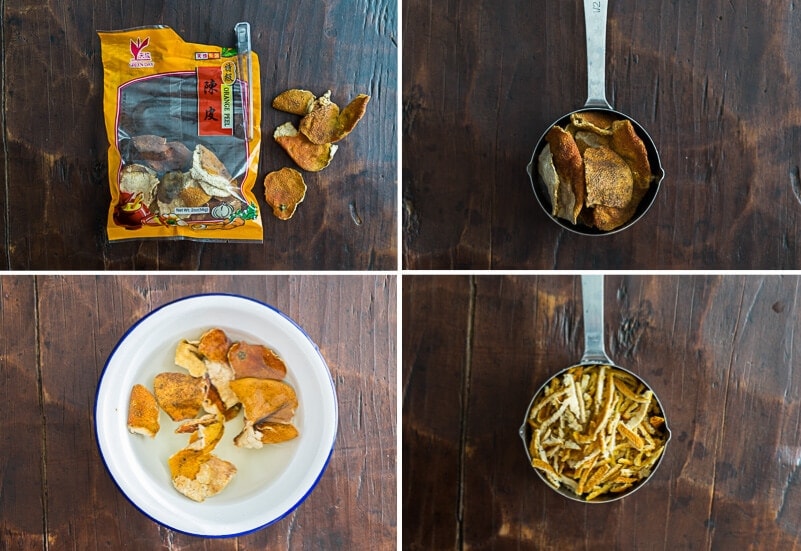
To use dried tangerine skins you need to rehydrate it first. Measure them by piling them loosely in a cup (they will expand quite a bit after soaking). Cover with hot water and let sit for 15 to 20 minutes. Once the peels turn soft, slice them into thin strips. Or, you can mince them if you like a more refined texture. Measure the sliced tangerine peel again. If you have extra rehydrated peels, store soaked peels in a fridge or let them air dry completely before storing them in a bag.
Don’t have an Asian market nearby? No problem. You can easily make them at home by air drying fresh tangerine peels. If you want to make this sauce today without it, you can use fresh orange zest instead. Your dish will still taste better than Panda Express.
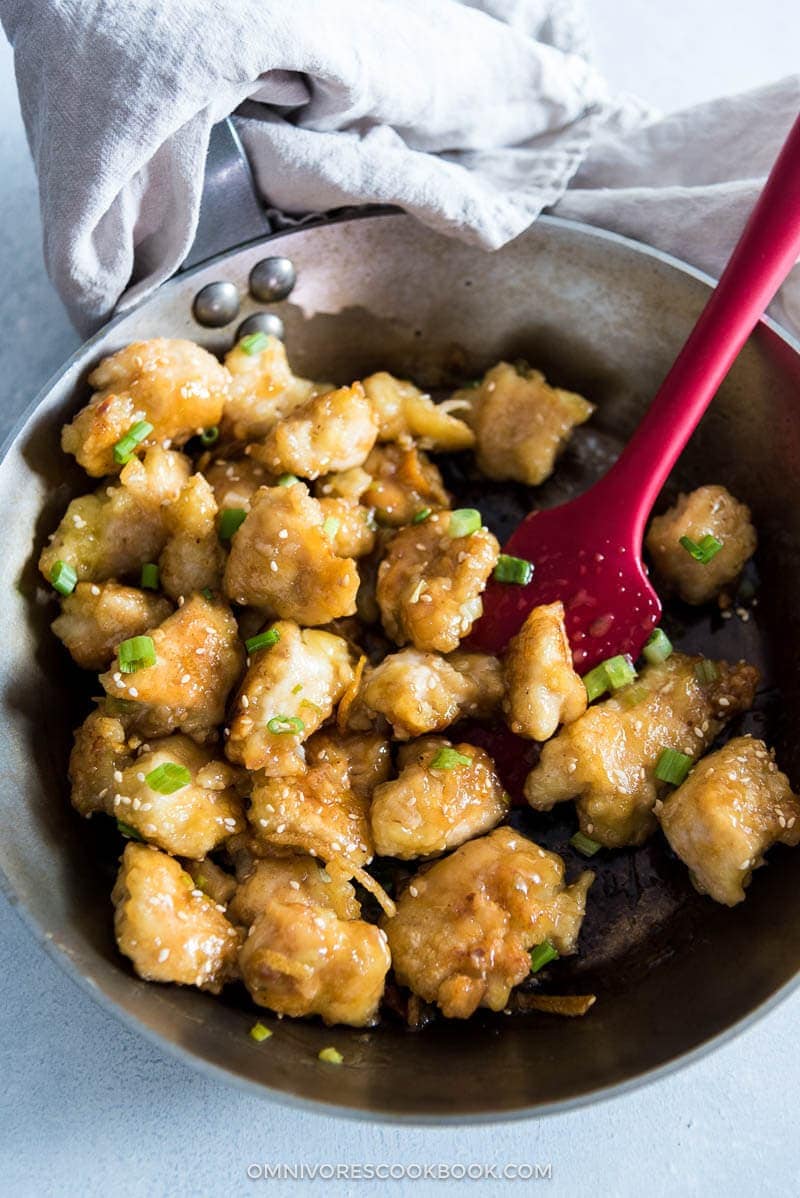
How to use the sauce
Simply reheat the sauce in microwave, you can add the sauce in stir fry or on roasted vegetables and protein!
(1) Recommended Protein and how to prep for stir frying
- Beef (flank steak or short ribs) – thinly slice (1/8 to 1/4-inch thick), or cut to strips
- Chicken (skinless boneless breast or thigh) – Diced to 1-inch pieces, or sliced to 1/4-inch thick
- Shrimps – peeled and deveined
- Tofu (firm or extra firm) – Diced to 1/2 to 2/3 inch pieces
For each pound of meat or seafood, mix with 1 tablespoon vegetable oil (or peanut oil), 1/2 teaspoon salt, and 1 tablespoon cornstarch. Let marinate for 5 to 10 minutes.
To create a crispy crust, restaurant-style, learn this method so you can achieve the goal without deep-frying.
For tofu, marinate with 2 tablespoons soy sauce for 10 to 15 minutes. Drain and coat with a thin layer of cornstarch.
(2) Recommended vegetables and how to prep for stir frying
To make a quick dinner, my favorite way is to only use one type of vegetable. You can use two, but no more.
Recommended vegetables
- Asparagus – Chopped to 1-inch pieces
- Baby bok choy – Tear off large leaves and halve lengthwise, halve or quarter the rest
- Bell peppers – Sliced or chopped
- Broccoli (fresh) – Divide to small florets; steam or blanch (see this post to learn how to blanch the broccoli quickly in the same stir fry pan)
- Broccoli (frozen) – Microwave for 2 to 4 minutes (depending on the quantity), so the broccoli is thawed and luke warm, but not heated up.
- Brussels sprouts – Roasted (see this post for how to roast Brussels sprouts).
- Cauliflower (fresh) – Divide to small florets; steam, blanch, or roast.
- Cauliflowers (frozen) – Microwave for 2 to 4 minutes (for stir fry), or roast (see this post to learn how to crisp up frozen cauliflowers in the oven)
- Carrot – Sliced into pieces or stripes (by using a julienne peeler); or cut to chunk and roast
- Eggplant – sliced (see this post to learn how to prep eggplant so it crisps up during stir fry)
- Green peas (fresh or frozen)
- Onion – Sliced
- Snow pea
(3) More delicious recipes by using homemade orange chicken sauce
If you give this recipe a try, leave a comment below, take a picture, and tag it @omnivorescookbook on Instagram! I’d love to see what you come up with! 🙂
Chinese Cooking Made Easy
Are you new to this website? This free email series is a great place to start. I’ll walk you through a few of my most popular recipes and show you how and why they work. You’ll quickly start to cook better Chinese food in your own kitchen.
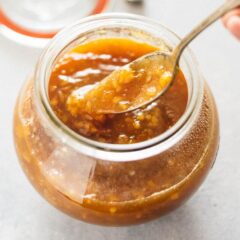
Homemade Orange Chicken Sauce
Ingredients
- 1 tablespoon vegetable oil (or grapeseed oil)
- 4 cloves garlic , minced
- 2 tablespoons ginger , minced
Sauce mix
- 1/2 cup loosely packed dried tangerine peel (or grated orange zest)
- 1 cup orange juice
- 3/4 cup rice vinegar (or distilled white vinegar)
- 1/4 cup light soy sauce (or soy sauce, or tamari for gluten-free)
- 1/4 cup Shaoxing wine (or Japanese sake, or dry sherry, or chicken stock)
- 1/2 cup sugar
- 2 1/2 tablespoons cornstarch
- 1 teaspoon fine sea salt
Instructions
- Add dried tangerine skin in a small bowl and add hot water to cover. Let soak for about 20 minutes, or until the tangerine skin softens. Drain and finely slice. Transfer 1/4 cup sliced tangerine skin into a bowl, and save the rest in a airtight container in the fridge for next time. If you do not use dried tangerine peel, grate about four fresh orange skins to make 1/2 cup orange zest.
- Add the rest of the sauce ingredients and the rehydrated tangerine skin to a big bowl. Stir until the cornstarch is fully combined.
- Heat oil in a saucepan until warm. Add garlic and minced ginger. Cook and stir until you smell a strong fragrance.
- Stir to mix the sauce again to completely dissolve the cornstarch. Pour into the pan. Cook and stir until the sauce thickens, just enough to coat the back of a spoon.
- Transfer the sauce into a bowl immediately, so it won’t continue to cook in residual heat.
- Transfer the sauce in a airtight jar or container once cooled down. Store in the fridge for 1 to 2 weeks, or in the freezer for 2 to 3 month.
Reheat
- Microwave sauce (1/3 cup to 1/2 cup) by 30 seconds increments. Then stir it and continue to heat until the sauce just turns hot without bubbling.
- If you heat the sauce on stovetop, always use low heat and stir the sauce frequently to prevent scorching.
- If you freeze the sauce, some of the liquid might separate and the thawed sauce looks like jelly. Simply stir to mix the sauce together and reheat in microwave or on the stove. You can restore the sauce to the previous consistency.
Nutrition

Did you make this recipe?
I’d love to hear how it turned out for you! Please take a moment to leave a 5-star rating ⭐️ and share your thoughts in the comments further down the page. It really helps others discover the recipe too.

SoCal Red
Delicious& easy. Superior to grocery store jar orange sauce. I had all the ingredients!
Omaida
This recipe sounds so good.
I have one question, can I use orange marmalade?
Maggie Zhu
You definitely can, but I don’y know the exact amount because I’ve never tested it. I would start with maybe 1/2 cup of the orange marmalade (skip the orange peel) and you probably need to reduce the sugar and / or the orange juice, so the taste is balanced.
Teresa
I am so happy to have found your recipe! I needed to make some sauce for orange chicken and I improvised because I am without a vehicle at the moment and needed to use what I had on hand. My husband raved that it was “restaurant quality” so I’m pretty happy about it and can only imagine how fantastic it would have been had I all the specific ingredients the recipe called for!
I used all ingredients as listed except – I used zest from one regular medium/large orange (didn’t make the 1/2 C but the amount was perfect, the end product was perfectly orange for us). I didn’t have soy sauce but I did have a teriyaki marinade with soy sauce as the 3rd ingredient, so I used two TB of this instead of soy sauce and I reduced the rice vinegar to 1/4 cup. I also used garlic powder (about 1 1/2 tsp) and 2 tsp ground ginger. I probably could have gone a little heavier on the garlic and ginger, but I could taste it in the sauce and it wasn’t overpowering. Consistency was perfect and the end product was sweet but not overly sweet, it was perfect with the chicken I made and it felt like I was eating takeout! I wanted to thank you for sharing this recipe and also let folks know they can be a little creative in a pinch with this recipe and still end up with a great sauce!
Alice Bennett
Can you use dry ginger???
Maggie Zhu
It’s possible to use dried ginger powder, but the fresh ones add a lot more flavor.
Molly McDonald
Hi! We love orange chicken and I’m looking forward to trying this soon. Can I use Mirin wine instead? I’m having a hard time finding Shaoxing wine.
Maggie Zhu
You can use mirin but the dish might turn out a bit sweeter since mirin is quite sweet.
shankar
So scrumptious bless your heart! In any case – it was my first time searing chicken, and it didn’t truly come out firm, any thought where I may have turned out badly? I seared each piece for about 2.5mins per side in veggie oil
Tatiana
Hello, Maggie!
Tremendously enjoy your recipes and your directions make so much sense. Thank you for keeping all your posts right to the point.
I have already tried many of your recipes – pho in different versions, stir fries, oyster sauce (my favorite!), many of the chicken recipes and, once again, wanted to tell you that love them all.
Last time I cooked the orange chicken and found out, that the chicken cooked (prior mixing with sauces) looked exactly as store bought version of cook-at-home orange chicken (Trader Joe’s version). I think next time, I’ll cook ahead of time and freeze it for a quick meal later!
But about the sauces for Sweet and Sour Chicken and Orange Chicken I have a question. I have found those sauces more tangy, than I like; moreover, when I made a batch for 5 lb of orange chicken, the taste of the sauce disappointed me. I have used freshly grated orange zest and the taste of the oranges was too strong. (I think I might messed it up somehow, as I know the math is not “X times everything”, when cooking for bigger batch)…
Would love to get your insight on my issue.
And, if you are planning on printing the book, I would love to buy it!
Please, make your recipes into physical book (not e-book)!
Thank you
Beth Wiggans
This recipe looks delicious. Instead of rehydrating dried tangerine peel could you use fresh tangerine peels.
Sharon
I thought there was too much rice vinegar in the recipe. I liked your recipe and followed it (couldn’t get the dried tangerine peel, though) and the taste of the vinegar was so strong and so acidic that I had to dilute the sauce with A LOT of water. I will make this recipe again, but I will cut the vinegar by 1/3 and gradually add more if needed.
kymber0524
Hello, Maggie and thank you so much for this sauce recipe! I probably need to tweak my ratios some as I used 1/2 cup loosely packed dehydrated organic orange peel bits found in the spice aisle of my grocery store. Like other spice ratios to fresh/homemade, I think that may be stronger or more than intended here. The next batch I think I’ll try 1/4 cup. I made my batch, shaking all listed ingredients in a mason jar, but had to leave them in the refrigerator a day or 2 before I could get back to them and get it on the stove. That did not seem to present any problems and may even have helped the flavors combine. I was amazed at how quickly the sauce thickened over heat.…beautiful! :]
Susan
I’ve been looking for an orange sauce recipe for quite some time and am really glad I found yours. The idea of focusing on the sauce and figuring out the mains later is terrific. No easily -accessible dried tangerine peel at my nearest Asian grocery but my handy-dandy dehydrator and I took care of that. It was simple and really tasty. The spousal unit just kept coming back for more! We had it with chicken and cauliflower, with sweet potatoes on the side, because I love the combo of sweet potatoes and orange. We will definitely be using this sauce frequently. Just getting ready to send the link to the kids so they can enjoy as well. Thanks!
Tess
This is the first time I’ve come across such an AMAZING sounding recipe! I’m so enthusiastic about trying this. It looks FABULOUS! THANK you!🤗
Love the simplicity of the ORANGE SAUCE! No need for marmalade! Awesome.
Justin M Kimball
Hey Maggie,
So I just made it (orange version, well clementine with some minor adjustment). I have half in a jar and another half for the freezer. Should I freeze some in teaspoon size in an ice cube tray? How much sauce do I use for a serving of say four? Is it like 1/4 cup or something? I am not sure I can use this up in two weeks if it is, say a tablespoon per serving of 4. Any advise on how to ration this out would be helpful.
I am really looking forward to having some of this on hand. I really hope the kids dig this, if they don’t screw ’em.
Maggie
Hi Justin, I would use 1/4 cup sauce for four if I just need enough sauce to coat the ingredients, and I would use 1/3 cup for four if you prefer more sauce.
I think the easiest way to freeze is to measure out the portion (say 1/3 cup), then put in a ziplock bag, press out air and seal. I think it’s easier to store and thaw (you can throw the bag into a big bowl of water and it will thaw in 15 minutes). Hope this helps and let me know if you have more questions 🙂
SARAH
That’s what I was looking for. THANK YOU SO MUCH.
Dave Nichols
Why are the oil, garlic, and ginger listed last if they aren’t actually used until last when the garlic and ginger are to her heated in the oil? For those of us who aren’t good cooks and often in a hurry, listing them last would be helpful and for good cooks or those with plenty of time, it shouldn’t matter. BTW my sauce with lime zest, too much ginger, and shiraz for the wine, came out fine! Can’t wait to try to with some chicken, etc. Thanks.